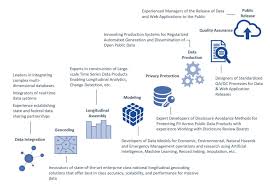Source:-analyticsinsight.net
Data scientists are taking on new importance as the difficulties of transforming raw data into an organisational resource has become increasingly daunting. Today, it is the data scientists as opposed to software developers who are probably going to be approached for the task. They have the knowledge and the tools to change over our monetary, operational, social and other information into valuable data, which thus helps government offices as well as other open and private sector organisations from numerous points of view.
State and local governments specifically need to make their data visible, open and helpful to its constituents. This not just makes it transparent and offers the public genuine peace of mind, it additionally enables external experts to contribute on the most proficient method to best use these tremendous amounts of data.
This procedure has already in system across various levels of government. Here are five different ways various government offices and agencies are utilizing data science.
Research in Healthcare
The National Institutes of Health (NIH) kickstarted an initiative named the Big Data to Knowledge (BD2K) to upgrade biomedical research. BD2K likewise serves to augment involvement of community and to encourage disclosure of new knowledge. It gives the ability to reap, control, and analyze biomedical big data so as to better know about the illnesses and human well-being.
The Food and Drug Administration (FDA) utilizes big data technologies in a recently launched Technology Transfer program to analyze and comprehend the patterns of foodborne diseases. It additionally utilizes data science to react all the more viably to the products which are contaminated in the food supply. The Center for Disease Control (CDC) rummages through social media to follow the spread of ailments, while the government is subsidizing a venture that can recognize the early indications of suicidal inclinations from social media behavior.
Environmental Protection
Both the CSIRO and Geoscience Australia have taken immense data management and analytical methods for the nation’s ecological protection and sustainability. Analytical simulations take into account all the more clear comprehension of environmental assets accordingly educating applicable parties on the most proficient method to best apportion and deliver water.
Likewise, the Clean Energy Regulator (CER) additionally profits by data analysis. The CER regulates schemes for measuring, overseeing, diminishing and balancing Australia’s greenhouse gases. With data simulation, it can better illuminate government strategy, meet global settlement commitments and support statistical services.
Government Education
The US Branch of Education is creating learning analytics and data mining frameworks that can screen and address an online student’s study design and identify fatigue from patterns of key snaps in real-time.
The Notice and Comment Project utilizes natural language processing and advanced analytics to track changes in laws, strategies, and guidelines in order to update the 4,000,000 or more government reports that it benefits people in general.
Fraud Detection
Fraud detection is a key territory where the government uses data management and analytics to the nation’s advantage. Alongside other government organizations, the CER reacts to fraud and non-compliance, and the Australian Electoral Commission (AEC) utilizes data simulations to explore electoral fraud.
Because of the sheer volume of data examined and watched, simulations can discover inconsistencies simpler than before. This procedure is sped along by the exceptionally gifted data scientists and experts that work across various government parts. They channel through the broad data and blend the consequences of the simulation to detect deceitful conduct in an exceptionally proficient way.
Battling Crime
The US Division of Homeland Security (DHS) is among the leading clients of data science in the government. The organization utilizes big data methodologies that incorporate interoperability to integrate and think about data from different security offices so as to anticipate or detect potential dangers to the nation.
The CIA-financed Palantir Technologies is in charge of an analytical software that battles terrorism by finding roadside bombs and battles cyber fraud by following transactions showing fake like patterns. All law authorization offices approach the Automated License Plate Recognition (ALPR) that recognizes vehicles claimed by individuals with remarkable warranties. Predictive tech likewise interfaces specific repeat offenders to specific crimes.
Maybe the most well-known example when law implementation utilized data science was after the Boston Marathon bombarding. They used Big Data tech to quickly break down more than 480,000 pictures and separate a few based on codes and algorithms composed based on the descriptions available of the suspect.
